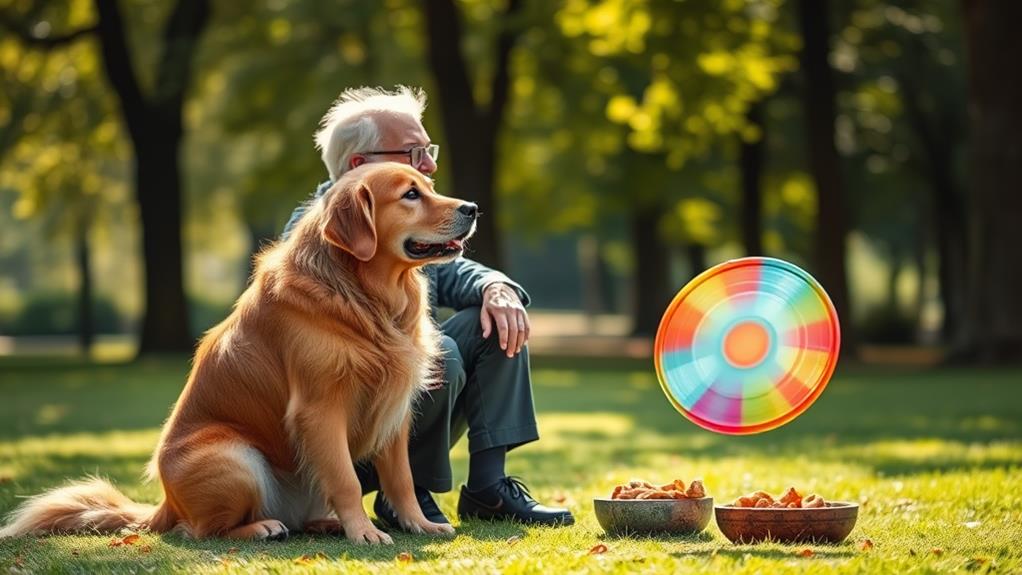Training older dogs can be rewarding with the right approach. First, understand their unique needs, like physical limitations and potential anxiety. Keep training sessions short, about 5 to 10 minutes, and focus on one command at a time to avoid confusion. Use positive reinforcement, rewarding them immediately with treats or praise. Consistency is key, so guarantee everyone uses the same commands. Make training fun by incorporating games and high-value treats. Be patient and flexible, recognizing their pace and celebrating small victories. Explore these strategies further to transform your training experience into a fulfilling journey for both you and your dog.
Understand Their Unique Needs

When training older dogs, it's crucial to understand their unique needs. Unlike younger pups, senior dogs may have physical limitations, such as arthritis or reduced vision and hearing. Recognizing these changes can help you tailor your training approach. For instance, you might need to modify the types of exercises you use or the duration of your training sessions to avoid putting too much strain on their bodies.
Older dogs often have established habits, both good and bad. Instead of trying to break these habits immediately, focus on reinforcing positive behaviors and introducing new commands gradually. Patience is key; your older dog might take a little longer to learn new tricks, but that doesn't mean they can't learn at all.
Moreover, consider their mental state. Many older dogs can suffer from anxiety or cognitive decline. Keep an eye on their stress levels, and create a calm, reassuring environment for training. Use gentle encouragement and positive reinforcement to build their confidence. By understanding and addressing these unique needs, you'll foster a more effective training experience that strengthens your bond with your older dog.
Keep Sessions Short

Typically, keeping training sessions short is indispensable for older dogs. Their attention spans can be limited, and longer sessions may lead to frustration or fatigue. Aim for 5 to 10-minute sessions, focusing on one or two commands or tricks at a time. This approach helps keep your dog engaged and allows them to absorb the information without feeling overwhelmed.
During these brief sessions, watch for signs of fatigue or boredom. If your dog starts to lose interest, it's time to wrap it up. Ending on a positive note is vital, as it reinforces the idea that training is enjoyable and rewarding.
Consider breaking up training into several short sessions throughout the day rather than one long session. This method can help reinforce the commands in a more digestible way. Plus, it offers more opportunities for bonding and fun!
Use Positive Reinforcement

Incorporating positive reinforcement into your training sessions can markedly enhance your older dog's learning experience. Instead of punishing mistakes, focus on rewarding good behavior. This approach creates a more enjoyable atmosphere for both you and your dog, making learning a positive experience.
Start by identifying what motivates your dog, whether it's treats, toys, or praise. Use these incentives to encourage desired behaviors. For example, if your dog sits on command, immediately reward them with a treat and enthusiastic praise. This reinforces the idea that good behavior yields positive outcomes.
Be specific with your rewards. Instead of just saying "good dog," try using your dog's name along with the praise, like "Buddy, great job!" This helps your dog connect the reward to the action. Keep the rewards varied to maintain your dog's interest and excitement in training.
Be Consistent With Commands

Consistency is key when training older dogs, and using the same commands for specific actions can significantly improve their response. When you choose a command, stick to it. For example, if you decide to use "sit" instead of "sit down," always use "sit" in every training session. This clarity helps your dog understand what you expect from them.
Establish a routine with your commands. Practice them regularly in different settings, whether at home, in the yard, or during walks. This repetition reinforces their meanings and makes your dog more confident in responding.
Make sure everyone in your household uses the same commands too. If one person says "come" while another says "here," it can confuse your dog. Consistency among family members creates a unified approach, ensuring your dog learns the commands faster.
Remember to be patient. Older dogs may take a bit longer to grasp new commands than younger ones, but your consistency will pay off. Celebrate small victories and keep the sessions fun and engaging. By sticking to your commands, you'll help your older dog feel secure and more willing to learn.
Focus on One Command at a Time

Training an older dog requires focus, and tackling one command at a time can lead to better results. When you concentrate on one command, your dog can grasp it more effectively, reducing confusion and frustration. This method helps reinforce learning and builds your dog's confidence.
Here's a simple table to illustrate how to approach training:
| Command | Tips to Reinforce |
|---|---|
| Sit | Use treats and praise immediately when your dog sits. Repeat until they associate the command with the action. |
| Stay | Begin with short durations, gradually increasing the time. Use a calm voice and reward for staying in place. |
| Come | Practice in a safe, enclosed area. Call your dog with enthusiasm and reward them when they come to you. |
Incorporate Daily Routines

Establishing a routine can substantially enhance your older dog's training experience. Consistency is key for dogs, especially as they age. By incorporating daily routines, you not only make training easier but also help your dog feel secure and confident.
Start by integrating training sessions into your dog's daily activities. Here are a few tips to keep in mind:
- Set specific times for training: Choose a regular time each day to practice commands. This predictability helps your dog know when to focus.
- Combine training with walks: Use your daily walks as opportunities for training. Reinforce commands like "sit" or "stay" while you're out and about.
- Incorporate mealtime training: Use your dog's meal times as a chance to reinforce commands. Have them perform a trick before you serve their food.
Make Training Fun

Making training enjoyable is essential for keeping your older dog engaged and motivated. To achieve this, incorporate games and play into your training sessions. Use their favorite toys or treats to encourage participation. For instance, you could turn a simple command like "sit" into a fun game by rewarding them with a toss of their toy when they comply.
Keep training sessions short—around 5 to 10 minutes—so your dog doesn't lose interest. Break up commands into smaller, manageable steps and mix them up. This variety keeps their mind active and makes learning feel less like a chore.
You can also use positive reinforcement. Celebrate their achievements, no matter how small, with praise, treats, or playtime. This not only reinforces good behavior but also strengthens your bond.
Don't forget to adjust the environment! Training in different locations can make it more exciting, whether it's the backyard, a park, or even inside the house.
Lastly, remain upbeat and cheerful throughout the process. Your enthusiasm will be contagious, encouraging your older dog to enjoy training as much as you do.
Be Patient and Flexible

When working with older dogs, patience and flexibility are crucial for success. These dogs may not learn as quickly as younger ones, and they might've physical limitations that require you to adjust your training methods. It's imperative to understand that every dog is unique, and what works for one may not work for another.
Take breaks: Older dogs may tire more easily, so allow for frequent breaks during training sessions. This keeps them engaged without overwhelming them.
Adapt your approach: If your dog seems frustrated or disinterested, switch up your training style or try a different command. Flexibility can lead to breakthroughs.
Celebrate small victories: Recognizing small achievements can boost your dog's confidence and keep them motivated. Be sure to reward any progress, no matter how minor it seems.
Use High-Value Treats

Using high-value treats can considerably guarantee your training sessions with older dogs. These treats should be special enough to grab your dog's attention and motivate them to engage in the learning process. Older dogs may be less enthusiastic about basic kibble, so offering something more enticing can make a significant difference.
Treat Type | Benefits | Notes |
| —————— | ————————– | ————————– |
|---|---|---|
| Soft Chews | Easy to chew, digestible | Great for sensitive teeth |
| Freeze-Dried Meat | High protein, flavorful | Use in small pieces |
| Peanut Butter | Popular and tasty | Verify it's xylitol-free |
| Cheese | Irresistible to many dogs | Use in moderation |
| Baby Carrots | Healthy and crunchy | Low-calorie option |
Monitor Physical Limitations

While high-value treats can enhance your training sessions, it's equally important to keep an eye on your older dog's physical limitations. As dogs age, they may experience joint pain, decreased stamina, or other health issues that can affect their ability to learn and perform. Recognizing these limitations guarantees you tailor your training to suit their needs.
Watch for signs of discomfort: Pay attention to any limping, reluctance to move, or changes in behavior. These can indicate that your dog is struggling physically.
Adjust training intensity: Shorter, more frequent sessions can be more effective than longer, intense ones. This approach allows your dog to focus without becoming fatigued.
Incorporate gentle exercises: Activities like walking or swimming can help maintain your dog's fitness without putting too much strain on their joints.
Frequently Asked Questions
Can Older Dogs Still Learn New Tricks Effectively?
Absolutely, older dogs can learn new tricks effectively! They may take a bit longer, but with patience and positive reinforcement, you'll find they're enthusiastic to engage and showcase their intelligence in fun ways.
What Are Signs That My Dog Is Too Tired to Train?
If your dog's lagging behind, lying down, or showing disinterest, they might be too tired to train. Watch for heavy panting or reluctance to engage; it is crucial to respect their limits and adjust training accordingly.
How Do I Handle Stubborn Behavior in Older Dogs?
Dealing with stubbornness in older dogs can feel like trying to move a mountain! Stay patient, use positive reinforcement, and keep training sessions short and engaging. Consistency and love will eventually break through their resistance.
What Equipment Is Best for Training Older Dogs?
When training older dogs, consider using a sturdy leash, comfortable harness, and high-value treats. These tools help reinforce positive behaviors, making training sessions more effective and enjoyable for both you and your furry friend.
Are Certain Breeds More Trainable as They Age?
Isn't it fascinating how some breeds seem to embrace learning as they age? While every dog's personality varies, breeds like Border Collies and Poodles often remain keen and adaptable, making training possible at any age.
Conclusion
Training your older dog doesn't have to feel like climbing Mount Everest! By understanding their unique needs and keeping sessions short, you can achieve incredible results. With a sprinkle of patience and a dash of fun, you'll initiate a world of possibilities for your furry friend. Remember, every command mastered is like finding a golden nugget of joy in your relationship. So grab those high-value treats and get ready to commence this unforgettable journey together!



